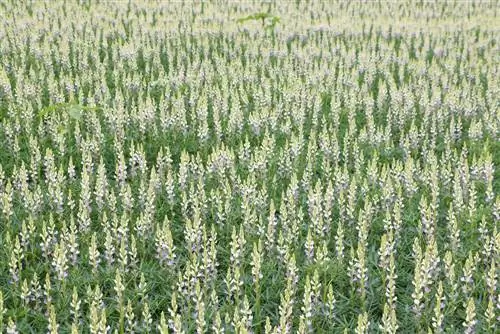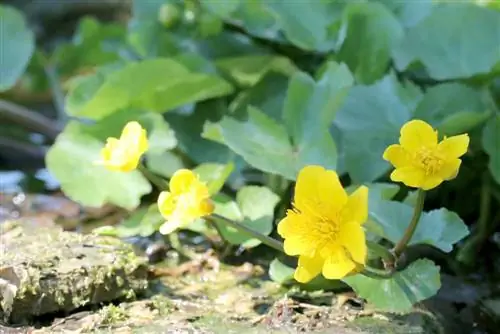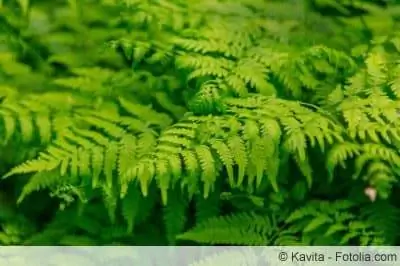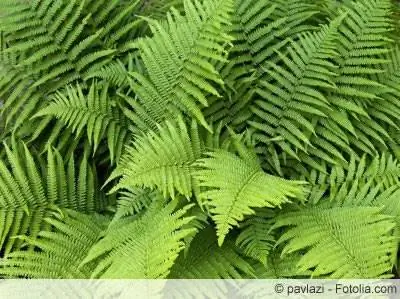- Author admin [email protected].
- Public 2023-12-17 03:39.
- Last modified 2025-06-01 06:48.
Lupins are becoming increasingly rare in the garden. Their importance in agriculture is constantly increasing. While the latter has good reasons, the declining trend as a garden plant is sad. Because the lupine is an enrichment for your own greenery, not just because of its flowers and impressive size. Even used beds benefit from the properties of the perennial, as they can improve the soil on several levels or just cover areas efficiently.
Location
Lupins usually reach an astonishing height of over one meter. However, heavily flowering cultivated forms are comparatively top-heavy due to their panicles. The plants are therefore vulnerable to wind, bend easily and break quickly. The lupins therefore primarily need a location protected from the wind. The planting site should offer enough upward space and plenty of sun. Warm, bright and protected - the south side near the wall or in the middle of a densely planted bed with taller plants is ideal for this. A location near a hedge is also an option.
Substrate
Gardeners don't have to be picky when choosing the substrate for lupins. As a soil improver and popular green fertilizer, the plants are anything but demanding. The soil should be lean, slightly acidic and permeable if a particularly beautiful flower is desired. Basically, any substrate that is not prone to waterlogging, i.e. is rather dry, is suitable. Very moist and compacted soils should therefore be loosened up with sand in advance, but nothing more than preparation is necessary for the lupins.
Tip:
As a green fertilizer and to increase soil quality, the lupine can also be grown specifically on used and polluted substrates and hooked under after flowering.
Watering and fertilizing
The lupins are very robust and undemanding plants with amazingly long roots. These grow up to two meters into the ground and can therefore draw on numerous nutrient reserves and water. Watering is therefore hardly necessary, even if it doesn't rain for a long time. However, this only applies to lupins that have already grown successfully. If the perennials have just been planted, they will require a little more care in the first few weeks or even months. Watering in particular is necessary for up to three months. Rainwater or soft tap water are ideal. Chemically untreated pond water can also be used to water the lupine. Between watering, even with young perennials, you wait until the soil has dried thoroughly.
As with watering, fertilizing is not necessary for the lupine after the first year of growth. It can then supply itself from the ground. Additional care only makes sense for young lupins that grow on very used and therefore extremely nutrient-poor soil. If you want to reduce the effort required for fertilization and watering, use pond water. The nutrients contained in this are already sufficient to supply. Alternatively, small amounts of compost can be used. The first dose is given at planting, with the compost being added directly to the planting hole. Two to three months later, some compost can be spread superficially around the perennials. Watering vigorously or fertilizing shortly before rainfall helps to distribute the nutrients evenly.
Propagate
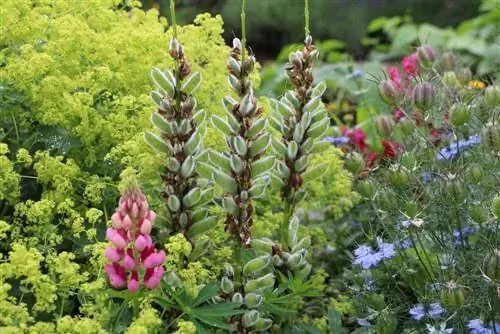
The lupine can be propagated via cuttings, division and sowing. There are some special features to consider, at least in the first two variants. Cuttings should be taken early in spring, directly after the first shoots. Then proceed as follows:
- So-called basal cuttings are cut around March, when the young shoots are around ten centimeters high. These are separated from the plant directly at the ground, i.e. as close to the roots as possible.
- The cuttings are placed in sterile potting soil so that there are about one to two centimeters in the substrate.
- A so-called cold box is recommended as a planter. So a cold frame that is not artificially heated.
- The cuttings should be kept bright and protected, but can withstand light frosts. They should be watered regularly, but should never be left wet.
- After two months at the latest, the basal cuttings should have taken root. This is clearly reflected in the growth and emergence of new leaves. Then they can be moved from the propagation box to the desired location.
The lupine can be propagated a little faster and easier by division. However, this measure is not always successful. The risk here lies in damaging the roots, which extend very far into the ground. It is therefore almost unavoidable that a large part of the root mass is lost. Nevertheless, this form of propagation is possible and is even recommended for rejuvenation in older lupins with declining flowering power. The following instructions reveal how this should be done:
- The possible times are late spring to early summer and early autumn. In any case, it is important that the first few weeks after dividing the lupine are frost-free.
- The perennial is dug up as widely and deeply as possible in order to preserve a lot of root mass. However, removing the substrate is not necessary and does not make sense due to the risk of injury to the roots.
- The plant is then divided in the middle. A sharp spade with a smooth and sharp edge is ideal for this.
- The resulting perennial parts are then planted separately, fertilized with compost or pond water and watered sufficiently.
The more roots are uninjured, the greater the chances of the lupins growing successfully.
Sowing
It takes little effort to propagate lupins from seeds, but it does require some patience. Unless the plants are left to sow themselves. The perennials self-sow up to seven meters wide, which is why they can become a real pest in the bed. If you want to fill a larger area with the attractively flowering plants, you just have to wait and keep weeds away.
If you want to prevent uncontrolled spreading, you should remove dried flowers as quickly as possible. Targeted sowing proceeds as follows:
- The seeds are obtained from the withered flowers. To do this, the flowers can be removed and shaken out in a cloth bag or, of course, seeds can be bought.
- Before sowing the seeds themselves, they are soaked in warm water for a day.
- The seeds are sown directly outdoors, with three to five seeds at the same point being lightly covered with soil.
- In the first eight to twelve weeks, you should water regularly and avoid complete drying out. However, floating is not necessary.
Early spring, around March, but also early autumn are possible times for sowing.
Intersection
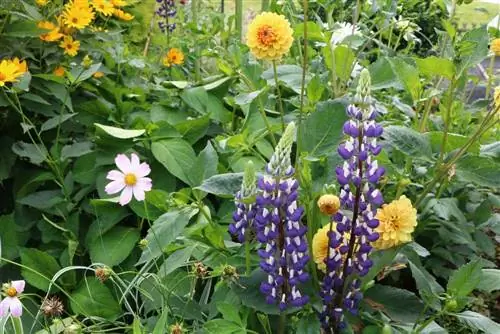
All that is necessary is a blend, which is carried out in the fall after the lupine has completely wilted. Alternatively, you can also cut a hand's width above the ground in spring - of course before budding.
Tip:
If you want to stimulate a second flowering of the year, cut the flower stems close to the ground immediately after they bloom in summer.
Wintering
Most lupins are hardy down to -25°C without any problems. Others can even tolerate temperatures below zero. Winter protection is therefore basically not necessary. The lupins can only suffer or benefit from covering in extreme frosts.
Soil improvement
Lupins improve soil quality in several ways. On the one hand, they can be planted on used soil and accumulate important nutrients in the soil. On the other hand, the extensive roots loosen the substrate even deep down. The clear advantage here is that while the soil is being improved, it also creates an eye-catcher in the garden.
Caution: Toxic
With special exceptions, lupins are poisonous and can quickly cause serious problems in people and animals. The seeds in particular should not be underestimated in their toxicity. If you have pets or children playing in the garden, you should avoid using lupins or make sure that there is neither accidental ingestion nor direct contact.
Typical diseases, pests and care errors
Basically, lupins are very robust in the garden and especially in the right location and are less susceptible to diseases and parasites. However, snails and mildew as well as constantly moist or even wet substrate can be dangerous. A snail-proof cover is therefore recommended for very young perennials and the first shoots in spring. If mildew occurs, a mixture of one part fresh whole milk and eight to nine parts water can be sprayed several times a week until the signs of disease disappear.
Conclusion
The lupine is a decorative flowering perennial with very low requirements that improves soil quality and can quickly overgrow open areas. Available in numerous colors and ideal for beginners in plant care as well as gardeners with little time, lupins have several advantages to offer.

